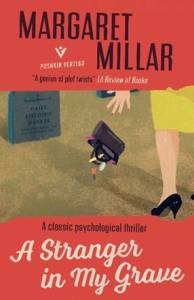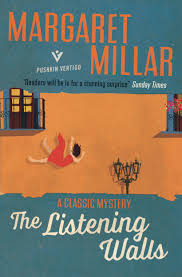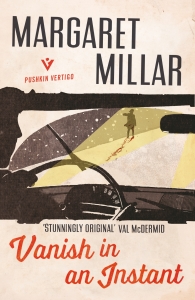A Stranger in My Grave – Margaret Millar
 ‘A Stranger in My Grave’, the second novel by US author Margaret Millar published by Pushkin Press as part of its eclectic collection of 1950s and 1960s crime stories (after ‘Vanish in an Instant’), is a brilliant work of fiction that, while firmly rooted in the crime/thriller genre, is also a thoughtful, engaging, and devilishly smart piece of writing.
‘A Stranger in My Grave’, the second novel by US author Margaret Millar published by Pushkin Press as part of its eclectic collection of 1950s and 1960s crime stories (after ‘Vanish in an Instant’), is a brilliant work of fiction that, while firmly rooted in the crime/thriller genre, is also a thoughtful, engaging, and devilishly smart piece of writing.
Millar has an eagle eye for the nuances of personality that make characters intensely alive, her dialogue is razor-sharp, and she isn’t afraid of tackling issues that are acutely topical in contemporary American society, to wit racism and genre politics, and were presumably even more uncomfortable to deal with at the time of the novel’s original publication in 1960.
For all of these virtues, ‘A Stranger in My Grave’ stands out as one of the best crime novels I’ve read and reviewed so far this year for its intricate, wonderfully disguised plot. Millar assembles the story not so much as a series of layers, each one peeled off for the readers to glimpse an unexpected twist in the plot, but as a genuine feat of novelistic optical illusion.
She tinkers with the perception readers have of the characters and plot line by constantly readjusting the angle of the story. A situation takes on a different shape entirely as the viewpoint changes, and the traits in a character’s personality are revealed as a series of subtle gradations, and not the same hue throughout, as it initially seemed. The end result of this authorial trickery is that the novel is packed full of surprises, down to the very last stunning line of text.
Even more cleverly, Millar achieves her optical illusions working with a large cast of characters, the majority of them deftly, sharply sketched. She has a knack for the unhackneyed, and hits the right note with each of the main personae in this thrilling story.
Starting with Daisy Harker, a 30-year-old housewife who seems suddenly bent on upsetting the placid balance of the life she’s enjoying in fictional San Felice, California (modelled on Santa Barbara, home to Millar and her husband Ken, better-known by his crime-writing pen name of Ross MacDonald). Daisy lives with her wealthy, doting husband, Jim, her loving though meddling mother, Ada Fielding, and her devoted dog Prince. But she is obsessed by a recurring nightmare in which she discovers, in the local cemetery, a grave bearing her own name and date of birth, the date of death going back four years, to December 2, 1955.
Against Jim’s and Ada’s advice, the latter in particular delivered in no uncertain terms, Daisy decides to find out what, if anything, happened to her on the date of her oneiric death. But can anyone remember exactly what happened in a day in one’s life four years before? As Daisy finds out, it’s easier said than done, and she struggles to recollect and reconstruct, growing increasingly paranoid about what might have happened to her on December 2, 1955.
This is perhaps not the strongest of premises in a crime novel, but Millar soon builds up a disturbing atmosphere around it: the grave Daisy so clearly recollects in her dream does exist in San Felice’s cemetery, that of Carlos Camilla, dead (a suicide as we later learn) exactly on December 2, 1955. And while Jim, Ada and Jim’s lawyer Adam Burnett all try to deflect Daisy from her quest to find out what happened on that day, her estranged father Stan Fielding crops up, muddying the waters with his larger-than-life presence.
Stan is an alcoholic, a man with the gift of the gab who’s unable to hold anything down for long, and has restlessly roamed the length and breadth of the US of A. He vanished from Daisy’s and Ada’s life fifteen years before, and only gets in touch with his daughter to ask for a ‘loan’ of some money. As he presently does, only he’s very close at hand, living in Los Angeles and urgently needing to be bailed out of a jail sentence after a drunken fight with a man whose wife Stan was possibly flirting with.
The wife, a young, down-at-heel Mexican woman called Nita, turns out to be Juanita Garcia, mother of six and known to both Daisy and, we soon discover, Jim. Daisy heeds Stan’s plea for financial help, and shows up at the bail bondsman’s office with the required cash. She won’t find her father there – he decides to fly the coop before she arrives – but strikes up a tentative acquaintance with bondsman Stevens Pinata, a young man with a troubled past who’s determined to make a success of his bail bond/detective agency business. Disappointed, clutching at straws, Daisy retains Pinata as a private detective, to find out what happened, to her and to dead Carlos Camilla, on the fateful December 2, 1955.
By this time, we’re only less than a third into the novel. A dead body has surfaced, Camilla’s death having been ruled a suicide but on suspiciously thin grounds, and Millar has patiently, adroitly spun a web of genuine or presumed links between her many characters and events, sustaining the plot even in the absence of such crime fiction staples as a police investigation or a lead detective. It works, and I was truly hooked, and never looked back until the novel’s last, pull-the-rug-from-under-your-feet line.
In between, Millar treats her readers to much more than a crime novel. She doesn’t shy away from building characters with troubled lives, suffering as much from family circumstances (Daisy was abandoned by her drunkard father, Pinata is an orphan) as from societal prejudice (Millar pulls no punches in penning a venomous portrait of the prejudices that at the time split California between Anglo-Saxons and Mexicans, or the way women were treated in what still was very much a man’s world) and from issues of their own doing (like Nita’s haphazard attitude to child-bearing or Stan’s alcoholism). All of these Millar treats with a touch as light as it is sharp, with a pithy prose and spot-on insights. And while the central part of the novel, in which Nita and Stan feature more prominently while Daisy seems to be on the back burner, initially felt to me as a tad off-focus, the detour proves to be eventually satisfying. Millar fleshes out the characters with gusto, and it all comes to fruition in the third part, where the narrative’s various strands converge to a brilliant denouement.
‘A Stranger in My Grave’ is a hugely interesting novel, one which strikes an ingenious balance between detective fiction and a more nuanced kind of narrative, brimming with insights on people and society that I presume were very relevant in 1960, and are certainly still relevant nowadays. Millar was a prolific author, publishing over 30 novels and being recognised in 1983 with the Grand Master Award by the Mystery Writers of America in recognition of her lifetime achievements, so there is plenty more to come from her should Pushkin Press, as I hope, continue to tap her rich vein of crime fiction.





